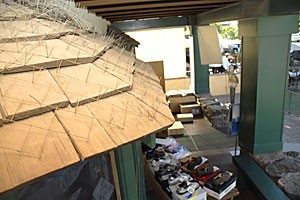It used to be, the pigeons outside of the Landmark Clothing and Shoes store would eat their corn ð- corn laced with psychoactive drugs ð- and fly away in a stupor, hopefully never to return.
The problem is that they did return, said owner Mort Edberg. He said he paid $200 for a regular service from a pest-control company to feed the pigeons corn for a few days, then, on the last day, infuse the corn with a hallucinogen so the birds would get disoriented in flight and be unable to find their way back.
Edberg said he used to take those measures because the pigeons were annoying to his customers, but the UA sees the birds as more than just a nuisance.
“”That’s probably our biggest problem in terms of health issues,”” said Chris Kopach, associate director of Facilities Management.
Kopach said the birds’ feces are a potential danger to students, especially if dried particles are accidentally inhaled.
UA custodial crews clean high-traffic entrances to all campus buildings every night, and Kopach said his department has invested in wire spikes over some of those entrances to deter pigeons from landing.
On the fountain of Main Gate Square yesterday afternoon, a group of the birds scuttled in all directions, their heads and their blank, orange-rimmed eyes frantically bobbing back and forth as they went.
Joel Suire, owner of the nearby Joel’s Bistro, 806 E. University Blvd., said any store or restaurant’s efforts to keep pigeons at bay could be complicated by neighboring businesses who don’t take the problem as seriously.
For his part, Edberg said he has always made getting rid of pigeons a priority. Some of the first things he did to the Landmark building, 876 E. University Blvd., were designed to limit its attractiveness to pigeons. He installed wire spikes on the roofs of some protruding windows and placed mesh in the corners of the awning over his porch.
But Edberg said some pigeons learned to “”hover”” like helicopters over the spikes and land slowly enough to be comfortable.
It was then that he resorted to the hallucinogenic corn, Edberg said.
“”All it did was get them to leave,”” Edberg said. “”But inside of a month they’d be back.””
Then, about five years ago, Edberg said he put up what he calls a “”squawker””: an automated speaker that makes the noises of predatory birds to scare pigeons away. He said since then, the birds haven’t been coming back.
Kopach said the UA tried using similar technology outside of the Kuiper Space Sciences building, but with less success.
“”That didn’t work at all,”” Kopach said.
The UA has also brought in two pairs of live owls, one at Arizona Stadium and one at the University Medical Center, he said.
While the UA does its best to deter pigeons from congregating on campus, there isn’t any way to make them go away completely, said Kopach, who added that poisoning them is not an option.
Danielle Rabins, a psychology senior, said she was sitting on the union patio at one of the tables outside McDonald’s about three weeks ago, and a pigeon defecated right on her table.
“”Even sitting here it makes me a little nervous,”” Rabins said while studying well underneath one of the patio’s red awnings.
Cal Bartol, manager of No Anchovies, 870 E. University Blvd., said his restaurant hoses down its outdoor patio each morning to get rid of any pigeon droppings.
For people who may not even be aware of all the health benefits of such efforts, they are still worthwhile.
“”Birds are kind of gross,”” Rabins said. “”Pigeons, at least. Those little ones aren’t so bad.””









